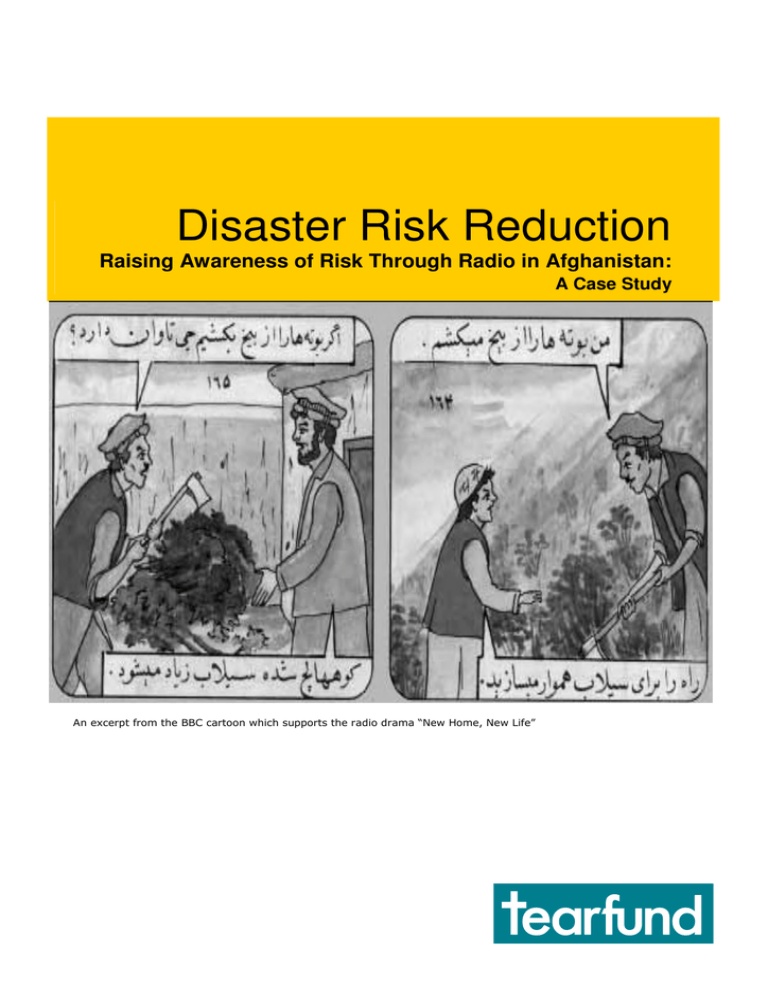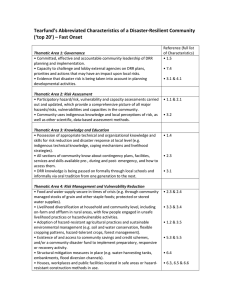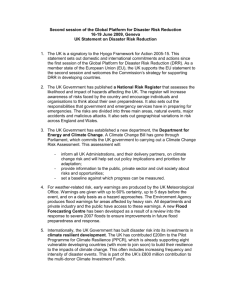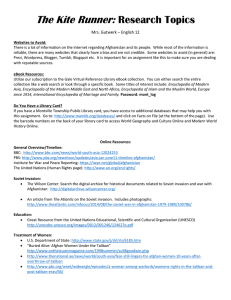Disaster Risk Reduction Raising Awareness of Risk Through Radio in Afghanistan:
advertisement

Disaster Risk Reduction Raising Awareness of Risk Through Radio in Afghanistan: A Case Study An excerpt from the BBC cartoon which supports the radio drama “New Home, New Life” Goals and Objectives The Initiative This is a disaster risk communication project based on the use of proven communication practices targeting local communities. Disaster risk reduction messages are integrated into the story lines of the very successful BBC educational radio programme called "New Home, New Life" (NHNL). As the NHNL was launched by the BBC World Service Trust 13 years earlier to support returning internally displaced Afghans, it is broadcast in two Afghan languages. The DRRrelated project includes a disaster based radio drama series set in a fictional remote village in Afghanistan. Afghanistan is not only a country that has suffered from wars and conflicts; it is also a country prone to earthquakes, avalanches, floods and drought, and its human development index (HDI) is one of the lowest in the world. Partly because of its mountain ranges, the country is also hindered by lack of transport; hence the existence of perhaps the most isolated villages in the world. These isolated villages happen to be extremely prone to disasters. In the light of this, and as 80 per cent of Afghans have radio sets in their homes and between 60 to 68 per cent of them listen to the above-mentioned NHNL, the idea of integrating disaster risk reduction (DRR) messages into the BBC programme was born. Moreover, Afghanistan's 2003 National Disaster Management Plan stresses the need to work closely with communities, yet much of the initial institutional strengthening was done at national and provincial levels. The Project therefore provided an entry point for community-level action. The idea was that DRR aware communities would be in a better position to engage with local government structures in the development of local disaster management plans. In view of the above, the major goal of the Project is to support the development of disaster-resilient communities across Afghanistan. Its major objectives are: 1. To raise community awareness of hazards and disaster risks; 2. To promote understanding of hazards and communities' vulnerabilities; and 3. To help communities enhance their capacities to address their vulnerabilities. Outcomes and Activities Following an initial period of research and consultation, Tearfund entered into a contract with the BBC World Service Trust in August 2006 for an initial one-year period. Because a large section of the Afghan population listens to NHNL and its supporting programmes, research for the DRRrelated radio programming is being conducted across a variety of different provinces, covering multiple hazards and involving programme recording with trained actors in the capital, Kabul. To maximize impact, NHNL not only bases its messages on the research conducted at community level, it also ensures that the messages are broadcast at certain hours of the day that suit women as well as men. Communities in Kapisa face multi-hazards including drought, floods, earthquakes, landslides and winterisation Photo: Oenone Chadburn A typical real-life community disaster reduction story picked by NHNL as an entry point for its programmes - and accompanying features and publications – is the following. One community recalled when forests of tamarind trees surrounding their village had been cleared so that the trees could be sold, and this resulted in heavy destruction caused by a flood. After hearing on NHNL, a few years ago, that destroying forests could lead to destructive flood impact on farms and houses, the community established a local council and decided to fine anyone who cuts trees. The forest trees have now been growing for 4-5 years and the community is happy with the many benefits accruing from them: no flood impact on houses, less dust, good pastures for animals, etc. It is early to understand the full impact of the DRR messages, but indications are that the communities are keen to listen and understand more about what they can do in times of disaster. Also, reports from an evaluation team include evidence of success by the previous story lines. An evaluation of the effectiveness of the messages is indeed being conducted, and those who use the programme material in their projects are also being asked to provide information on their effectiveness. The Context As between 60 to 68 per cent of those who have radio sets in Afghanistan listen to the BBC programme which is broadcast five times a week in the Dari and Pashtu languages, the DRR messages have reached a wide audience. Between two to four times per month, a programme on the findings of research conducted at community level and an expert-advised story line on disaster issues are broadcast. The story lines are generally hazard specific and are run for up to a period of four months as a re-occurring theme (e.g. April to August on earthquakes). The programmes are rebroadcast at different times of the day and are aired on a variety of radio frequencies and channels to ensure wider audience. The story lines have been operating since July 2006. 3 Lessons Learned Good Practice The key lessons learned from this project are: The good practice in the Project lies in the commitment of NHNL to make the programme as accessible and acceptable as possible to Afghan communities. The comprehensive research on the context of the issues faced by communities makes the programme very popular. Also, the programme design team has a clear understanding of dialects, accents and listeners' motivations. And the involvement of experts - such as Tearfund – to support and advise on key messages responding to the communities' felt and expressed needs helps ensure relevance and effectiveness. • The messages need to be integrated effectively into a drama that is entertaining. Indepth analyses of issues are needed but they are not always possible. • The opportunity to get community social networks or mobilizing structures to discuss the messages needs to be nurtured. It is hoped that the above-mentioned separate stand-alone audio stories will help trigger local debates. • There is a need to work closely with the BBC to ensure that its staff members have an understanding of the basic concepts of DRR. This would help script writers communicate the messages effectively in a culturally relevant way. Moreover, an innovative element is the fact that NHNL is also supported by a series of supplementary feature programmes which expand on some of the issues raised in the dramas. The feature programmes pick the findings of the community research and communicate actual examples of community actions or evidence of learnt messages. The feature programmes also provide supporting information for community structures to debate the issues raised. NHNL also has a quarterly publication that repeats the messages in cartoon format for partners to circulate and use in their discussions with communities. The BBC World Service Trust can also produce children's publications relating to the messages, which can be used in formal and informal learning methods. Another innovative element is the use of community radio to reach some communities which sometimes can be reached only after a three-day donkey-riding journey. Community radio is a cost-effective and effective way to reach the large section of the population (80 per cent) who have radio sets in their homes. Indeed, the communities' remoteness makes hands-on community-based projects extremely difficult, if not impossible Key Success Factors NHNL can be integrated into any community based DRR project implemented in Afghanistan. The programme story lines will be extracted onto a separate set of audios which can be used in a standalone setting. Also, Tearfund's current chairmanship of the Disaster Risk Reduction Consortium in Afghanistan will facilitate the circulation of the audios. The Consortium is an NGO network linked to the Government and the UN and which is dedicated to sharing good practices and lessons learnt. The programme can address multi-hazard issues in one setting. Displacement and migration is still common place in Afghanistan, and understanding the different hazards that communities could face when they are displaced into a new location is also beneficial www.tearfund.org 100 Church Road, Teddington, Middlesex TW11 8QE Challenge House, 29 Canal Street, Glasgow G4 0AD Rose House, 2 Derryvolgie Avenue, Belfast BT9 6FL Overseas House, 3 Belgrave Road, Rathmines, Dublin 6 Uned 6, Parc Gwyddoniaeth, Aberystwyth, Ceredigion, SY23 3AH 0845 355 8355 (ROI: 00 44 845 355 8355) enquiry@tearfund.org Registered Charity No. 265464 We are Christians passionate about the local church bringing justice and transforming lives – overcoming global poverty.






